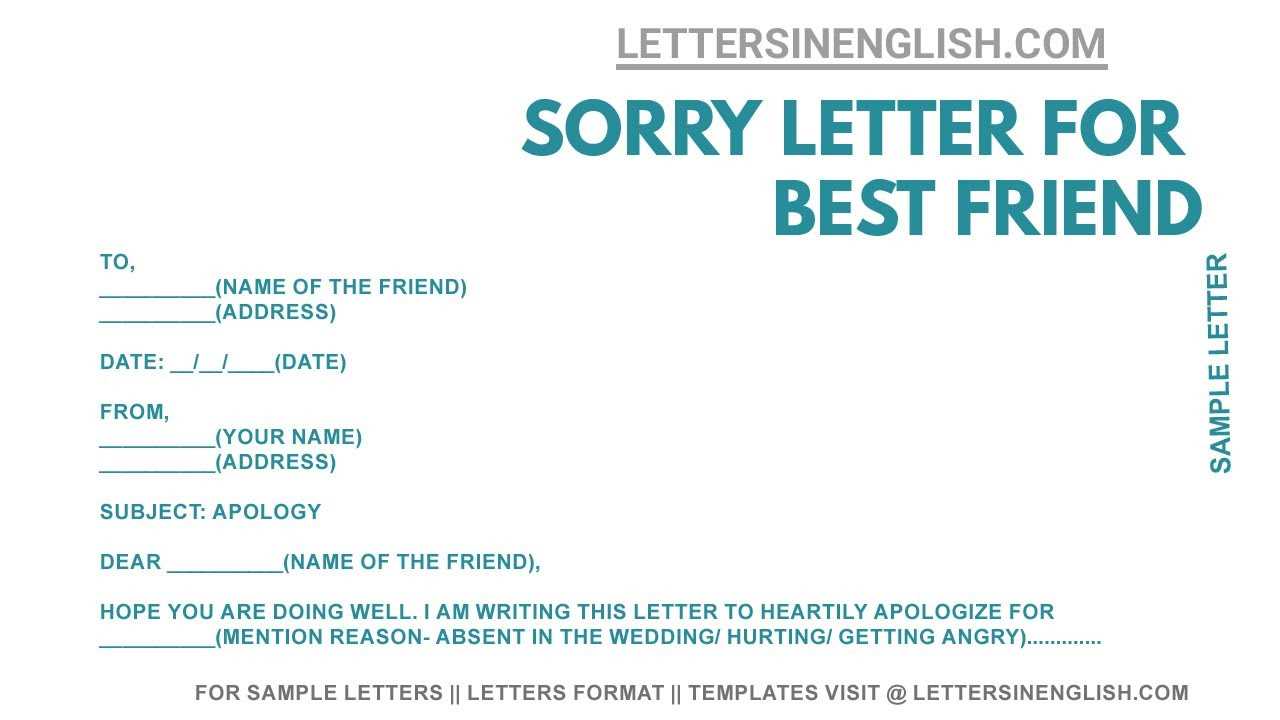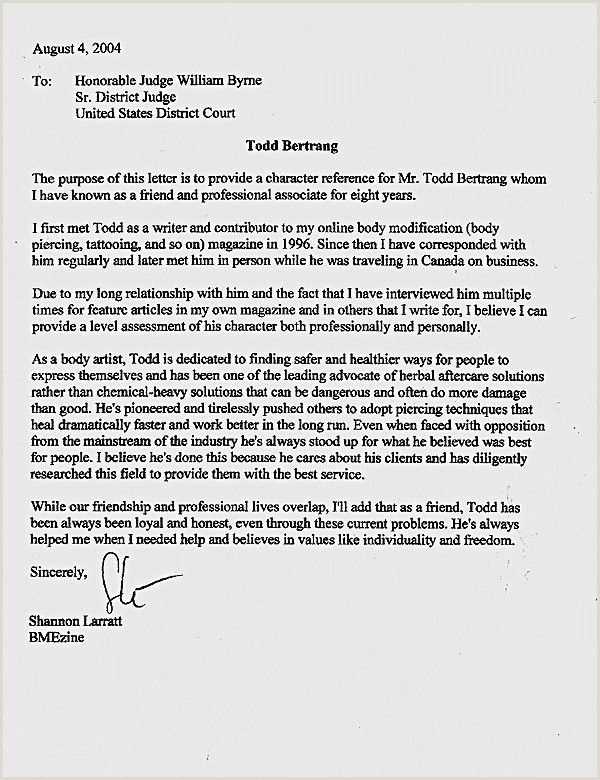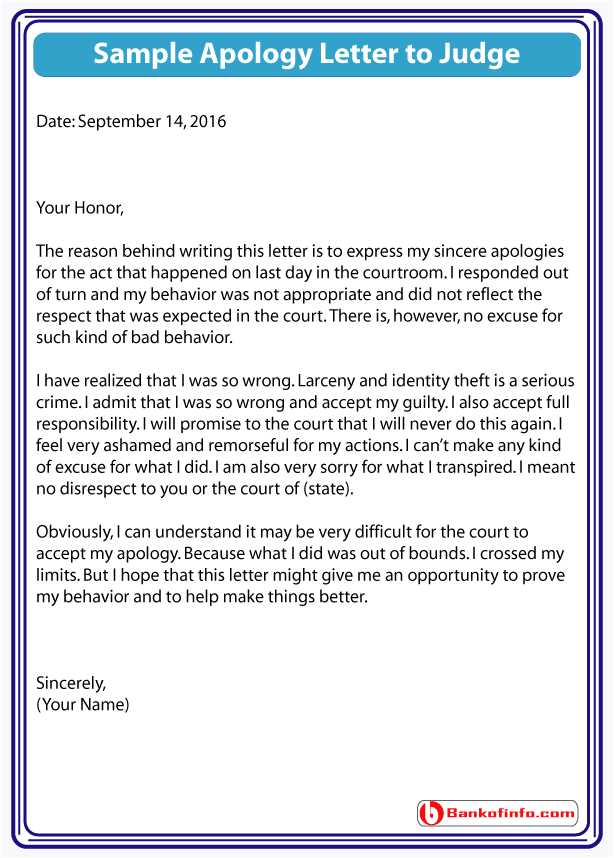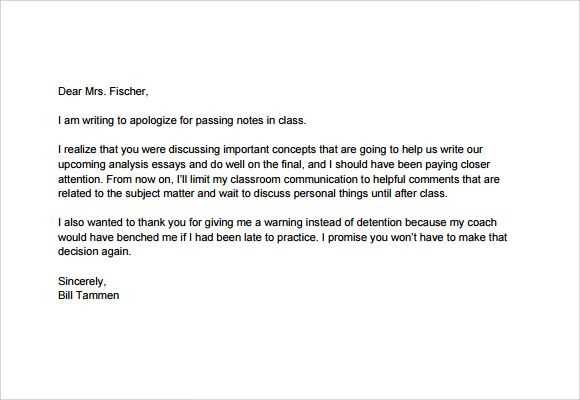Letter of remorse and regret to judge template

When writing a letter of remorse and regret to a judge, it is crucial to approach the task with sincerity and clarity. Begin by expressing your genuine acknowledgment of the offense and the impact it may have caused. Avoid making excuses, and instead, take full responsibility for your actions. Judges appreciate when individuals show true contrition and understanding of their mistakes.
Structure the letter clearly: Open with a respectful salutation and immediately state the purpose of your letter. In the body, describe how you’ve reflected on the situation and the lessons you have learned. Be concise but specific about the steps you’ve taken to make amends, whether through community service, counseling, or other corrective actions.
Focus on your personal growth: Highlight any positive changes you’ve made since the incident. Acknowledge how the experience has influenced your perspective and behavior. This shows that you’re not just seeking leniency, but also taking responsibility for your actions in a meaningful way.
Close the letter with a humble expression of regret, reaffirming your commitment to avoiding similar mistakes in the future. A well-crafted letter can demonstrate your accountability and sincerity, making a positive impression on the judge.
Letter of Remorse and Regret to Judge Template
Begin your letter by acknowledging the gravity of the situation and your awareness of the impact of your actions. Express genuine remorse for the harm caused, showing that you understand the consequences and take full responsibility. Avoid vague language and make your regret clear by stating specific actions you regret and how they affected others.
Next, provide context for your behavior, without making excuses. If applicable, explain any circumstances that may have influenced your actions, but avoid shifting blame. This demonstrates reflection and an understanding of your responsibility.
Apologize directly to those you have wronged, whether the victim or the community. A sincere apology is a key part of the letter, showing that you recognize the hurt you caused. Acknowledge the impact of your actions on the judicial system and the role it plays in ensuring justice.
Address any steps you have taken or plan to take to correct your behavior. Highlight any efforts toward personal growth, such as counseling, community service, or making restitution. This shows that you are committed to change and reducing the likelihood of future incidents.
Conclude the letter by reiterating your remorse and respect for the court’s role in upholding the law. Keep the tone respectful and professional, and avoid asking for leniency directly. Instead, focus on demonstrating your desire to learn from your mistakes and make amends.
How to Begin Your Letter: Addressing the Judge Properly
Begin your letter by addressing the judge respectfully and clearly. The proper salutation sets the tone for the rest of your letter and demonstrates your respect for the court. Use the judge’s title and last name, such as:
- “Your Honor” – This is the most common and universally accepted form of address.
- “Judge [Last Name]” – If you know the judge’s last name and prefer a more formal approach, this is appropriate.
Ensure your salutation is polite and without any familiarity. Avoid casual greetings such as “Dear Judge” or “Hi [Name].” Always maintain a formal tone from the outset.
If you’re unsure about the judge’s specific title, “Your Honor” is a safe and respectful option. This form of address is widely understood and expected in legal communications.
Choosing the Right Tone: Balancing Sincerity and Respect
Start by keeping your language clear and direct. Acknowledge your actions and express genuine remorse. Avoid overly emotional or apologetic phrasing that might come across as insincere. Your tone should convey responsibility without appearing dismissive or self-pitying.
When addressing the judge, maintain a respectful and formal tone. Acknowledge the authority of the court while remaining humble. Use polite but straightforward language, refraining from making excuses or justifying your actions. This shows that you accept responsibility without over-explaining or undermining the seriousness of the matter.
Avoid sounding defensive or overly formal, as it may create a barrier between you and the judge. Instead, focus on the specific impact your actions have had, and clearly outline the steps you’ve taken to make amends. This shows that you understand the situation and are actively working to improve.
Balance sincerity with respect by avoiding extremes. Stay focused on your regret and the steps you’ve taken to address the issue. Acknowledge the situation’s seriousness while demonstrating that you’re ready to learn and grow from the experience. Keep your tone honest, straightforward, and reflective of your personal responsibility.
What to Include: Key Points of Your Apology and Regret

Be specific about the actions that led to the situation. Acknowledge what happened and why it was wrong. This shows that you understand the consequences of your actions and their impact.
1. Acknowledge Your Mistake

Clearly describe what you did wrong. Avoid vague statements. Take full responsibility for your actions without trying to shift blame.
2. Express Your Regret

Share how you feel about the situation. Explain the disappointment, guilt, or remorse you feel. Let the judge know that you deeply regret your behavior and the consequences it caused.
3. Show Understanding of the Impact
Explain how your actions affected others, whether individuals, the community, or the judicial system. Acknowledge the harm caused and show empathy for the affected parties.
4. Offer a Plan for Change
Show that you have reflected on your actions and are committed to making changes. Detail any steps you are taking to ensure the situation doesn’t repeat itself. This could include attending counseling, participating in rehabilitation, or engaging in community service.
5. Apologize Directly
Address the judge directly with a heartfelt apology. Acknowledge the position of authority they hold and express your sincere regret for the inconvenience or harm your actions have caused.
6. Make a Commitment to Do Better
End your letter by committing to improved behavior. Reassure the judge that you understand the importance of your actions and will work to avoid making the same mistake in the future.
How to Express Accountability: Taking Responsibility for Your Actions
Admit your mistake directly. Avoid vague language or shifting blame. Acknowledge the harm or impact your actions had, and provide specific details about what went wrong.
Focus on what you can control. Take ownership of your behavior and decisions. Recognize where you went wrong and avoid excusing it. This shows maturity and respect for those affected.
Offer a clear plan for making amends. Explain the steps you’re taking to prevent the mistake from happening again. This demonstrates commitment to improving and repairing any damage done.
Express genuine regret. Let the person know you understand the consequences of your actions and that you’re truly sorry for the harm caused. Acknowledge how it affected others.
Be open to feedback. Show willingness to listen and learn from the situation. This not only helps in resolving the matter, but also in gaining trust for the future.
| Step | Action | Why It Matters |
|---|---|---|
| Admit the mistake | Directly acknowledge the issue | Shows accountability and transparency |
| Take ownership | Accept full responsibility | Demonstrates maturity and respect |
| Offer a plan for change | Explain corrective steps | Indicates commitment to improvement |
| Express regret | Acknowledge the impact | Builds trust and empathy |
| Listen to feedback | Be open to suggestions | Shows growth and willingness to learn |
Demonstrating Personal Growth: Showing Efforts Toward Improvement
To show your efforts toward improvement, focus on tangible steps you’ve taken to change your behavior. Highlight specific actions that demonstrate accountability and a commitment to self-betterment. This includes enrolling in programs, attending counseling, or seeking mentorship in areas that directly relate to the offense or situation at hand. Provide evidence of your participation, such as certificates, letters of recommendation, or a detailed account of your progress.
Set Clear Goals and Achievements
Outline concrete goals you’ve set for yourself, such as improving decision-making or enhancing emotional regulation. Track progress through measurable results–whether that’s completing coursework or receiving positive feedback from those you’ve worked with. Showing how these goals align with the changes you are striving for makes your growth more believable and convincing.
Show Accountability and Reflection
Demonstrating personal growth means acknowledging past mistakes without excuses. Share how you’ve reflected on your actions and the impact they’ve had on others. Be specific about the steps you’ve taken to correct those behaviors. This reflection helps convey sincerity in your desire to improve and build trust moving forward.
When you articulate the efforts you’ve made and the improvements you’ve seen, you provide a clear picture of your commitment to personal growth. This approach will show the judge that your past actions don’t define you, and you’re genuinely working toward becoming a better version of yourself.
Concluding Your Letter: Ending with a Clear Request for Understanding

Close your letter with a direct and sincere appeal for the judge’s understanding. Clearly express that you recognize the gravity of the situation and emphasize your commitment to making amends. Let the judge know how the consequences have affected you and how you are taking responsibility for your actions.
Make your request specific–for example, ask for leniency based on the efforts you’ve made to rectify the situation. Suggest any reasonable alternatives that could serve as a fair resolution. Show that you have a genuine desire to learn from the experience and avoid repeating past mistakes.
Don’t leave any ambiguity in your closing. Acknowledge that the decision is in the judge’s hands, but humbly request their understanding and compassion based on the steps you are taking to improve. Reinforce your remorse and your willingness to make things right, ensuring that your sincerity is felt in your final words.
Example of a concluding statement: “I kindly ask for your understanding and consideration as I work to make amends and move forward with a renewed sense of responsibility.”